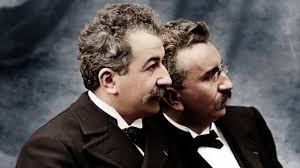“The Birth of Cinema: How the Lumière Brothers and Early Innovators Revolutionized Storytelling

Pics : Studiobinder
The introduction of cinema signified a pivotal period in human communication, fundamentally changing the way narratives were conveyed and encountered. In the late 19th century, the first cinema, a remarkable example of ingenuity and originality, was established, therefore laying the foundation for the dynamic and varied film industry that exists in the present day.
The genesis of cinema may be attributed to the development of the motion picture camera and the subsequent production of the first film projections. The trip commenced with trailblazers such as Thomas Edison and the Lumière brothers, who played crucial roles in the advancement of early cinema.
Thomas Edison, an American inventor, and his helper, W.K.L. Dickson, engineered the Kinetoscope, an early motion picture apparatus, in 1891. The Kinetoscope enabled people to see brief audiovisual films using a peep-hole viewer. Although not classified as a projector, it marked a crucial milestone in the advancement of cinematic technology. First films produced for the Kinetoscope were short, lasting just a few minutes, but they demonstrated the possibilities of moving images.
Concurrently, in France, the Lumière brothers, Auguste and Louis, were engaged in the development of their own distinctive cinematic advancements. In 1895, the Cinématographe was introduced, a device capable of simultaneously capturing and projecting moving images. This innovation revolutionised the cinema industry by enabling the screening of films to bigger audiences instead than being limited to individual viewers. On December 28, 1895, the Lumière brothers organised their inaugural public exhibition at the Grand Café in Paris, showcasing ten short films that included renowned titles like Workers Leaving the Lumière Factory and Arrival of a Train at La Ciotat. It is largely acknowledged that this significant event marked the start of cinema as we understand it today.

Pic : The History News
In their short films, the Lumière brothers skilfully depicted ordinary occurrences using a documentary-style technique. An innovative development that sparked worldwide fascination in the medium was its capacity to display dynamic visuals on a screen for a fee-paying audience. Following the success of their first screening, cinemas quickly proliferated, and film projections gained popularity as a form of entertainment throughout Europe and beyond.
The initial stages of film were marked by rigorous experimentation and groundbreaking innovation. Filmmakers and inventors globally initiated the exploration of diverse methods to augment the visual and narrative elements of their films. George Melies, a French illusionist and animator, conducted experiments with special effects and narrative techniques in the United States, resulting in the creation of imaginative films like A Trip to the Moon (1902). His work innovatively expanded the limits of cinema’s potential, paving the way for subsequent generations of filmmakers.
As cinema progressed, it diversified into an array of genres and forms, mirroring the many interests and cultures of global viewers. The initial films established the groundwork for the evolution of narrative cinema, as progress in technology and innovative storytelling methods propelled the expansion of the film sector.
The inaugural cinema was not just a technological advancement, but also a significant cultural achievement that fundamentally transformed the realms of entertainment and narrative. The enduring influence of cinema persists beyond generations, since it consistently enthrals and motivates viewers with its capacity to depict human experiences and emotions. The inception of cinema, which sprang from the Lumière brothers’ public screening, and has evolved into the dominant worldwide film business, is a significant milestone in the realms of art and communication.